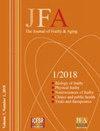老年门诊患者阑尾瘦质量与虚弱
IF 3.3
Q2 GERIATRICS & GERONTOLOGY
引用次数: 1
摘要
这项观察性研究的目的是检验60岁及以上成年人阑尾瘦块与虚弱之间的关系。这项研究是在越南河内国家老年医院门诊部进行的。使用双能X射线吸收仪扫描评估阑尾瘦质量(kg)。虚弱是根据弗里德的虚弱标准来定义的。共有560名门诊患者参与了这项研究,平均年龄为70岁。虚弱的患病率为12.0%。与非虚弱门诊患者相比,虚弱患者的阑尾瘦质量显著较低(9.6±2.0 kg vs.11.7±3.1 kg,p<0.001)。在多变量逻辑回归模型中,较高的阑尾瘦块与明显降低的虚弱几率相关(校正OR=0.74,95%CI 0.59-0.93)。这些发现表明,在老年门诊就诊的老年患者中应考虑评估阑尾瘦块。本文章由计算机程序翻译,如有差异,请以英文原文为准。
Appendicular Lean Mass and Frailty among Geriatric Outpatients
The objective of this observational study was to examine the association between appendicular lean mass and frailty in adults aged 60 years and older. This study was conducted in the Outpatient Department of the National Geriatric Hospital in Hanoi, Vietnam. Appendicular lean mass (kg) was assessed by using Dual energy X-ray absorptiometry scans. Frailty was defined according to Fried’s frailty criteria. A total of 560 outpatients were included in the study, with a mean age of 70 years. The prevalence of frailty was 12.0%. Frail patients had significantly lower appendicular lean mass compared with non-frail outpatients (9.6 ± 2.0 kg vs. 11.7 ± 3.1 kg, p<0.001). On multivariable logistic regression models, higher appendicular lean mass was associated with significantly reduced odds for frailty (adjusted OR = 0.74, 95%CI 0.59–0.93). These findings suggest that the assessment of appendicular lean mass should be considered in older patients attending outpatient geriatric clinics.
求助全文
通过发布文献求助,成功后即可免费获取论文全文。
去求助
来源期刊

Journal of Frailty & Aging
GERIATRICS & GERONTOLOGY-
CiteScore
5.90
自引率
7.70%
发文量
54
期刊介绍:
The Journal of Frailty & Aging is a peer-reviewed international journal aimed at presenting articles that are related to research in the area of aging and age-related (sub)clinical conditions. In particular, the journal publishes high-quality papers describing and discussing social, biological, and clinical features underlying the onset and development of frailty in older persons. The Journal of Frailty & Aging is composed by five different sections: - Biology of frailty and aging In this section, the journal presents reports from preclinical studies and experiences focused at identifying, describing, and understanding the subclinical pathophysiological mechanisms at the basis of frailty and aging. - Physical frailty and age-related body composition modifications Studies exploring the physical and functional components of frailty are contained in this section. Moreover, since body composition plays a major role in determining physical frailty and, at the same time, represents the most evident feature of the aging process, special attention is given to studies focused on sarcopenia and obesity at older age. - Neurosciences of frailty and aging The section presents results from studies exploring the cognitive and neurological aspects of frailty and age-related conditions. In particular, papers on neurodegenerative conditions of advanced age are welcomed. - Frailty and aging in clinical practice and public health This journal’s section is devoted at presenting studies on clinical issues of frailty and age-related conditions. This multidisciplinary section particularly welcomes reports from clinicians coming from different backgrounds and specialties dealing with the heterogeneous clinical manifestations of advanced age. Moreover, this part of the journal also contains reports on frailty- and age-related social and public health issues. - Clinical trials and therapeutics This final section contains all the manuscripts presenting data on (pharmacological and non-pharmacological) interventions aimed at preventing, delaying, or treating frailty and age-related conditions.The Journal of Frailty & Aging is a quarterly publication of original papers, review articles, case reports, controversies, letters to the Editor, and book reviews. Manuscripts will be evaluated by the editorial staff and, if suitable, by expert reviewers assigned by the editors. The journal particularly welcomes papers by researchers from different backgrounds and specialities who may want to share their views and experiences on the common themes of frailty and aging.The abstracting and indexing of the Journal of Frailty & Aging is covered by MEDLINE (approval by the National Library of Medicine in February 2016).
 求助内容:
求助内容: 应助结果提醒方式:
应助结果提醒方式:


